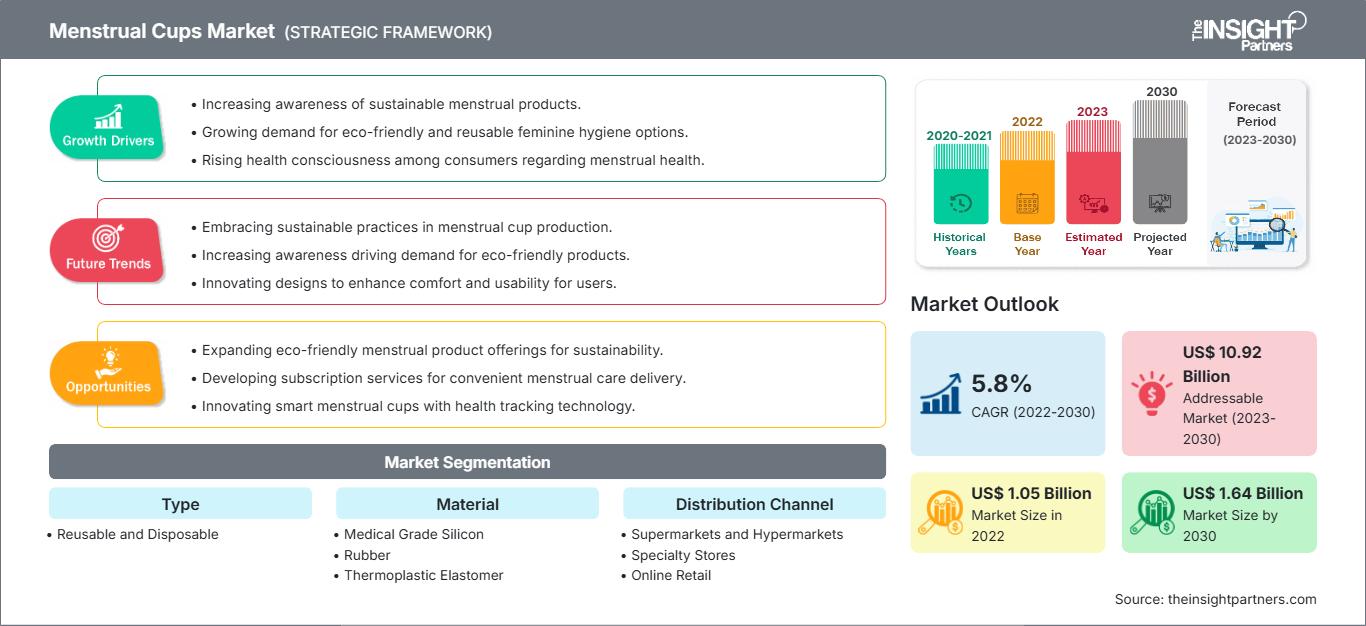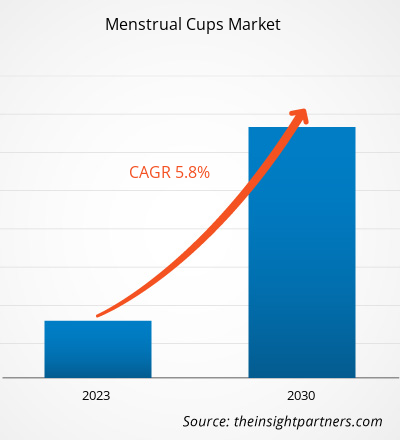[調査レポート] 月経カップ市場規模は2022年に10億5,081万米ドルと評価され、2030年には16億4,406万米ドルに達すると予測されています。また、2022年から2030年にかけて5.8%のCAGRで成長すると予測されています。
市場分析とアナリストの見解:
月経カップは、月経中の女性の衛生のために設計された、再利用可能なベル型の器具です。通常、医療グレードのシリコンまたはゴムで作られたこれらのカップは、従来のタンポンやナプキンのように月経液を吸収するのではなく、膣に挿入して月経液を収集します。漏れを防ぐために密閉し、最大12時間着用できるため、使い捨て製品に代わる持続可能で費用対効果の高い選択肢となります。月経カップは、従来の生理用品に比べて環境面でのメリットがあり、長期的なコスト削減にもつながることから人気が高まっています。
成長要因と課題:
持続可能な生理用品への需要の高まりが、月経カップ市場を牽引する主な要因です。近年、世界的に持続可能性へのシフトが進んでおり、従来の使い捨て生理用品が環境に与える影響に対する消費者の意識が高まっています。従来のナプキンやタンポンはプラスチック廃棄物に大きく貢献しており、その製造には資源とエネルギーの消費が伴います。平均的な女性1人当たりの年間廃棄物量は約150キログラムです。インドだけでも、約1億2,100万人の女性と女児が毎月平均8枚の使い捨てまたは堆肥化できないナプキンを使用しており、毎月10億2,100万枚、年間123億枚、年間11万3,000トンの生理廃棄物が発生しています。月経カップは、再利用可能なことから環境に優しい代替品を求める人々の間で、主要な選択肢として浮上しています。環境意識の高まりから、消費者は環境負荷を最小限に抑える製品を選ぶようになり、月経カップの需要が高まっています。
持続可能な月経用品への需要の高まりは、女性の健康と幸福を推進する幅広い運動と密接に結びついています。消費者は、環境に優しいだけでなく、安全で健康に有益な製品をますます重視するようになっています。月経カップは通常、医療グレードのシリコン、ゴム、または熱可塑性エラストマーで作られており、安全で衛生的であるとされており、従来の製品によく見られる炎症やアレルギー反応のリスクを軽減します。環境の持続可能性と女性の健康という観点から、月経カップの魅力が高まり、人気が高まっています。
要件に合わせてレポートをカスタマイズ
レポートの一部、国レベルの分析、Excelデータパックなどを含め、スタートアップ&大学向けに特別オファーや割引もご利用いただけます(無償)
月経カップ市場: 戦略的洞察

- このレポートの主要な市場動向を入手してください。この無料サンプルには、市場動向から見積もりや予測に至るまでのデータ分析が含まれます。
レポートの一部、国レベルの分析、Excelデータパックなどを含め、スタートアップ&大学向けに特別オファーや割引もご利用いただけます(無償)
月経カップ市場: 戦略的洞察

- このレポートの主要な市場動向を入手してください。この無料サンプルには、市場動向から見積もりや予測に至るまでのデータ分析が含まれます。
生理用品の持続可能性を求める声は、使い捨て製品の環境への影響に関する意識向上を目指す様々な支援団体、NGO、政府の取り組みによって高まっています。持続可能な月経を促進するキャンペーンは、月経カップのような再利用可能な代替品の利点について一般の人々を啓蒙する上で重要な役割を果たしてきました。持続可能な月経習慣の認知度と支持が高まることで、消費者の態度が前向きに変化し、月経カップの受容と採用が促進されます。
持続可能な生理用品の需要は、環境に配慮した選択を優先する若い世代の消費者によっても高まっています。特にミレニアル世代とZ世代は、パーソナルケアを含むさまざまな業界で持続可能で倫理的な製品の需要を牽引しています。これらの世代の意識と好みは市場動向に影響を与え、持続可能で先進的な選択肢である月経カップは、彼らの価値観とよく合致しています。この年齢層の購買力が高まり続けるにつれて、月経カップの需要も高まり、持続可能な主要な月経用品としての市場での地位を強化するでしょう。
しかし、消費者の認識と無知は月経カップ市場における大きな制約となり、世界的な普及率に影響を与えています。包括的な教育と啓発キャンペーンが不足しているため、多くの人が月経カップの利点について知らないままです。製品やその利点(費用対効果、環境への影響の低減、装着時間の延長など)に馴染みがないことが、潜在的なユーザーが従来の月経用品から切り替えるのをためらう一因となっています。この知識不足は誤解や躊躇につながり、月経カップが現実的で実用的な代替品として広く受け入れられるのを妨げる可能性があります。
月経カップの使用をためらう理由は、挿入と取り外しの難しさへの懸念に根ざしていることがよくあります。月経カップの使い方に慣れるまでの期間が、自分には到底及ばないレベルのスキルや快適さが必要だと勘違いし、障壁と捉えている消費者も少なくありません。月経カップの簡単な使用方法や潜在的な健康効果に関する理解不足も、こうした不安を助長しています。こうした先入観や誤解を払拭するには、月経カップの使いやすさ、快適さ、そして環境への良い影響を強調する、的を絞った教育活動が必要です。こうした懸念に対処し、意識を高めることで、市場は誤解を払拭し、潜在的なユーザーの間で月経カップに対するより肯定的な認識を促進することに貢献できるでしょう。
レポートのセグメンテーションと範囲:
世界の月経カップ市場は、種類、素材、流通経路、地域に基づいてセグメント化されています。種類別では、再利用可能と使い捨てに分類されます。素材別では、医療用シリコン、ゴム、熱可塑性エラストマーに分類されます。流通経路別では、スーパーマーケットやハイパーマーケット、専門店、オンラインストアなどに分類されます。地域別に見ると、世界の月経カップ市場は、北米、ヨーロッパ、アジア太平洋、中東およびアフリカ、南米および中米に大まかに区分されています。
セグメント分析:
タイプに基づいて、月経カップ市場は再利用可能と使い捨てに分類されます。再利用可能セグメントは、2022年から2030年にかけて最も高いCAGRを記録すると予想されています。再利用可能な月経カップは、月経衛生における持続可能で費用対効果の高い革命を表しています。通常、医療グレードのシリコン、ゴム、または熱可塑性エラストマーから作られたこれらのベル型のカップは、従来のタンポンやナプキンのように月経を吸収するのではなく、膣に挿入して月経の流れを集めます。素材の柔軟性と柔らかさにより、快適で使いやすいことが保証され、ユーザーの体型に適応します。再利用可能な月経カップは最大12時間着用でき、漏れのない保護を提供し、ユーザーがより柔軟に月経を管理できるようにします。再利用可能な月経カップの最大の利点の1つは、環境への影響です。カップは再利用できます。カップを使用することで、月経廃棄物の量が大幅に削減され、環境に優しい月経ケアルーチンの実現に貢献します。さらに、長期的なコスト削減と、使い捨て製品を定期的に購入する必要がない利便性から、月経衛生における持続可能で実用的な代替品を求めるユーザーの間で、再利用可能な月経カップはますます人気の選択肢となっています。
地域分析:
月経カップ市場は、北米、ヨーロッパ、アジア太平洋、中南米、中東アフリカの5つの主要地域に分割されています。2022年には北米が世界の月経カップ市場を支配し、同地域の市場規模は3億9,541万米ドルに達しました。ヨーロッパは2番目に大きな貢献者であり、世界市場の30%以上のシェアを占めています。アジア太平洋地域は、2022年から2030年にかけて5%を超える大幅なCAGRを記録すると予想されています。アジア太平洋地域における月経カップの需要急増は、文化的な変化の高まり、意識の高まり、女性の健康の重要性の高まりなど、さまざまな要因に起因しています。多くのアジア諸国では、月経にまつわるタブーを打ち破る動きが高まっています。
COVID-19パンデミックの影響:
COVID-19パンデミックは当初、製造ユニットの閉鎖、労働力不足、サプライチェーンの混乱、金融不安により、世界の月経カップ市場を阻害しました。COVID-19の発生による経済減速により、さまざまな業界で操業が中断され、月経カップの供給が抑制されました。さらに、多くの店舗が閉鎖され、月経カップの販売が制限されました。しかし、2021年には各国で以前に課されていた制限が解除されたため、ビジネスは回復し始めました。さらに、各国政府によるCOVID-19ワクチン接種キャンペーンの実施により状況が緩和され、世界中でビジネス活動が増加しました。月経カップ市場を含むいくつかの市場は、ロックダウンと移動制限の緩和後に成長を報告しました。
月経カップ市場の地域別分析
予測期間を通じて月経カップ市場に影響を与える地域的な傾向と要因については、The Insight Partnersのアナリストが詳細に解説しています。このセクションでは、北米、ヨーロッパ、アジア太平洋、中東・アフリカ、中南米における月経カップ市場のセグメントと地域についても解説しています。
月経カップ市場レポートの範囲
| レポート属性 | 詳細 |
|---|---|
| の市場規模 2022 | US$ 1.05 Billion |
| 市場規模別 2030 | US$ 1.64 Billion |
| 世界的なCAGR (2022 - 2030) | 5.8% |
| 過去データ | 2020-2021 |
| 予測期間 | 2023-2030 |
| 対象セグメント |
By タイプ
|
| 対象地域と国 | 北米
|
| 市場リーダーと主要企業の概要 |
|
月経カップ市場のプレーヤー密度:ビジネスダイナミクスへの影響を理解する
月経カップ市場は、消費者の嗜好の変化、技術の進歩、製品の利点に対する認知度の高まりといった要因により、エンドユーザーの需要が高まり、急速に成長しています。需要が高まるにつれ、企業は製品ラインナップの拡充、消費者ニーズへの対応、そして新たなトレンドの活用を進めており、これが市場の成長をさらに加速させています。

- 入手 月経カップ市場 主要プレーヤーの概要
競争環境と主要企業:
世界の月経カップ市場で活動している有力企業としては、Nixit、Lunette Global、Lena Cup LLC、Diva International Inc.、Saalt、Pixie Cup、June Cup、Cora、The Flex Company、Blossom Cup などが挙げられます。
- 過去2年間の分析、基準年、CAGRによる予測(7年間)
- PEST分析とSWOT分析
- 市場規模価値/数量 - 世界、地域、国
- 業界と競争環境
- Excel データセット
最新レポート
お客様の声
購入理由
- 情報に基づいた意思決定
- 市場動向の理解
- 競合分析
- 顧客インサイト
- 市場予測
- リスク軽減
- 戦略計画
- 投資の正当性
- 新興市場の特定
- マーケティング戦略の強化
- 業務効率の向上
- 規制動向への対応




















 無料サンプルを入手 - 月経カップ市場
無料サンプルを入手 - 月経カップ市場